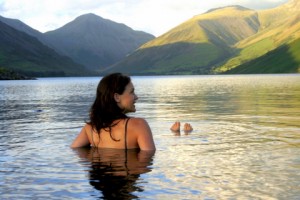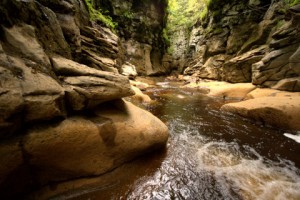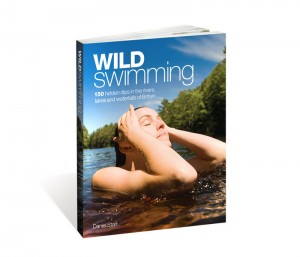Wild Swimming
Posted on May 29, 2008 by Amy Lenzo
Immersing yourself in the wildness, magic and history of Britain
by Daniel Start
 When I was young, the rambling old house we shared with two other families came with lakes, woods, streams and an overgrown boat house. Situated deep in the heart of the Wye valley, close to the Welsh border, in the UK, it was here my brother and I first learned to make dams, build rafts and explore the river.
When I was young, the rambling old house we shared with two other families came with lakes, woods, streams and an overgrown boat house. Situated deep in the heart of the Wye valley, close to the Welsh border, in the UK, it was here my brother and I first learned to make dams, build rafts and explore the river.
I loved one stream in particular. Gushing and snaking its way down the side of the Black Mountains, its mossy dingles and foxglove-filled dells enchanted me. Plunging into deep pools and sliding down chutes, my brother and I spent much of our summer squealing and slithering along its helter-skelter of cascades.
Twenty years on I could still hear that river as I worked my way through a variety of office jobs. When I told friends about the fun we had, they too recalled favourite swimming memories, glazing over with nostalgic fondness. During one particularly sweltering summer night, I began imagining a journey that would take me back to all these beloved childhood places. And so the idea evolved: with the help of my friends I would compile a connoisseurs’ handbook of the most delicious dips and drinkable vistas of Britain – finding the places where people still swim and collecting stories about the art of wild-swimming. Published in May 2008 you can see more about the book and the photo tour of Britain’s wild waters at the Wild Swimming website.
One branch of evolutionary theory, expounded by Sir Alistair Hardy in the 1950s, suggests that being by and in water is more than just a pleasure, it is at the core of our human condition. During the ten million years of the Pliocene world droughts, while our species was busy evolving into uprightness, we did not, suggests Hardy, choose the arid deserts of Africa as our home, as mainstream evolutionists believe, but the more tempting turquoise shallows of the nearby Indian Ocean. There we became semi-aquatic coastal waders. Our subsequent life on dry land is a relatively recent and bereft affair.
Could this explain some of our more peculiar habits and features?  Apart from the proboscis monkey, we are the only primate that regularly plays in water for the sheer joy of it, and whose offspring take naturally to water from birth. We are also alone in having subcutaneous fat, like a whale’s blubber, for buoyancy and warmth. We are almost hairless, like the dolphin, and what little hair remains is arranged to make us streamlined for swimming.
Apart from the proboscis monkey, we are the only primate that regularly plays in water for the sheer joy of it, and whose offspring take naturally to water from birth. We are also alone in having subcutaneous fat, like a whale’s blubber, for buoyancy and warmth. We are almost hairless, like the dolphin, and what little hair remains is arranged to make us streamlined for swimming.
Perhaps this is why Greek art and mythology abounds in stories of water nymphs, naiads and sirens as magical, sexual, mischievous creatures, inhabiting their wild ‘nymphaea’: natural pools, rivers and swimming holes, so beautiful they lure unwitting mortals to their watery ends.
As the nineteenth century dawned, a new era of contemporary European artists were rediscovering the appeal of the swimming hole. The waterfall, surrounded by trees and mountains, was now regarded as the quintessence of beauty. Wordsworth, Coleridge and de Quincy spent much time bathing in the mountain pools of the Lake District. The study and search for the ‘picturesque’ and ‘sublime’ – an almost scientific measure of loveliness and proportion in the landscape – had reached epidemic proportions. The fashionable tours of Provence or Tuscany were replaced by trips to the valleys of Wales, and the dales of Cumbria and Yorkshire, as Turner and Constable painted a prodigious flow of falls, tarns and ponds.
As the Romantic era took hold, the water held its place in the artists’ gaze. Ruskin and others moved south to paint the river pools of Cornwall and Devon. Meanwhile, Charles Kingsley was dreaming of water babies on the Devon Dart and Henry Scott Tuke was opening his floating studio in Falmouth, painting scenes of children swimming in the river. Soon Francis Meadow Sutcliffe gained notoriety for his Water Rats photograph of naked boys, while across the Atlantic Thomas Eakins was creating a stir with his homoerotic painting of the Swimming Hole. Water and nudity were pushing at the boundaries of rigid Victorian society and creating space for new ideas, freedoms and creativity.
 Pools and springs have long been revered by our Celtic and pagan ancestors. Even the Romans built shrines to the water goddesses, and several accompany the bathhouses along Hadrian’s Wall. Fresh water was seen as a sort of interface with the spirit world, a place where miracles – or curses – could manifest. ‘Mermaid Pools’ dot our Pennine mountain tops and ancient holy wells and springs are found across the Welsh and Cornish hills. No wonder, then, when Christianity came the Britons were quick to embrace river baptism as a doorway to a new god.
Pools and springs have long been revered by our Celtic and pagan ancestors. Even the Romans built shrines to the water goddesses, and several accompany the bathhouses along Hadrian’s Wall. Fresh water was seen as a sort of interface with the spirit world, a place where miracles – or curses – could manifest. ‘Mermaid Pools’ dot our Pennine mountain tops and ancient holy wells and springs are found across the Welsh and Cornish hills. No wonder, then, when Christianity came the Britons were quick to embrace river baptism as a doorway to a new god.
From a secular perspective the health and psychological benefits of dipping in natural waters were also long known. George Bernard Shaw, Benjamin Britten, Charles Darwin and Florence Nightingale were all advocates of regular cold baths to strengthen the mental constitution and physical state. Cold immersion soothes muscle aches, relieves depression and boosts the immune system. All wild-dippers know the natural endorphin high that raises mood, elates the senses and creates an addictive urge to dive back in. However the world seemed before a swim, it looks fantastic afterwards.
The long-term impacts are also well researched: NASA studies have shown that, over a 12-week period, repeated cold swimming leads to substantial bodily changes known as ‘cold adaptation’. These bring down blood pressure and cholesterol, reduce fat disposition, inhibit blood clotting and increase fertility and libido in both men and women. Far from quelling passion, a cold shower will boost vitality and desire.
By the 1870s, river- and lake-based recreation was entering mainstream culture. London was expanding at a rate of knots and the middle- and working-class population woke up to the potential of the Thames, with its villages, boats and watering holes lying only a cheap rail fare away. ‘We would have the river almost to ourselves,’ recalled Jerome K. Jerome, ‘and sometimes would fix up a trip of three or four days or a week, doing the thing in style and camping out.’ In 1888 he wrote the best-selling Three Men in a Boat, which was a manifesto for a simple way of living: close to nature, with river swimming before breakfast. Ratty declared in Wind in the Willows that there ‘was nothing, simply nothing, more worthwhile than messing about in boats’ and by 1909 Rupert Brooke was writing poems about bathing in Grantchester.
It was an idyllic period. Europe had been relatively peaceful for a hundred years. It was an age of relaxed elegance, of 25-mile-a-day walking tours, sleeping under canvas and bathing in the river. Brooke spent his days studying literature, swimming, living off fruit and honey and commuting to Cambridge by canoe. His passion for the outdoor life was shared by writers Virginia Woolf and E. M. Forster, philosophers Russell and Wittgenstein, economist Keynes and artist Augustus John. As they swam naked at Byron’s Pool in moonlight and practised their ‘belly-floppers’ in picnic diving practice along the Cam this nucleus formed the emerging Bloomsbury Group and what Woolf later dubbed the ‘Neo-Pagans’.
Grantchester Meadows became the site of one of the first formal bathing clubs in the country, with an elegant pavilion, separate changing areas and stone steps down into the warm waters of the river Cam. Similar clubs, ‘Parsons’ Pleasure’ and later ‘Dames’ Delight’, quickly followed at the Cherwell in Oxford. Soon every major public school was following suit with its own special riverside swimming facilities. By 1923 over 600 informal river swimming clubs were in existence around the country with regular inter-county river swimming competitions and galas. Henry Williamson was swimming with Tarka the Otter, and Arthur Ransome immortalised the Lake District in Swallows and Amazons. Wild-swimming had reached its heyday.
The post-war years in Britain brought a great thrust of industry and development and rivers bore the brunt of the pollution. By the 1960s pesticides had driven the West Country population of otters to near extinction. It was not until new legislation was introduced in the 1970s and 1980s that the trend began to turn. Thirty years on, over 70 per cent of our rivers are in good or excellent condition again. They are hidden havens for wildlife once more, secret corridors into forgotten corners of our countryside. For many of us this kind of communion with our ecology is moving. It’s a place to seek inspiration, intuition and peace and also to be humbled by the immensity and wonder of nature. These are places where children see their first kingfisher or find their first otter track. Here we learn to play Pooh sticks and build dams before falling asleep in the grass. Use this book to open up a fresh world of adventures, romantic escapades and family days out. The water’s fresh, so pick up, strip off and jump in!
‘I can go right up to a frog in the water and it will show more curiosity than fear. The damselflies and dragonflies that crowd the surface of the moat pointedly ignore me, just taking off for a moment to allow me to go by them, then landing again on my wake. In the water you are hidden and submerged, enveloped in the silkiness of a liquid that is the medium of all life on earth.’
— The late Roger Deakin, author of Waterlog, naturalist and forefather of wild-swimming, describing swimming in his moat in Suffolk.
 Wild Swimming:
Wild Swimming:
150 hidden dips in the rivers, lakes and waterfalls of Britain
by Daniel Start
Published by Punk Publishing – the publishers of themCool Camping series.
Wild Swimming by Daniel Start celebrates 150 hidden dips in the rivers, lakes and waterfalls throughout the length and breadth of Britain. Daniel has spent the last five years discovering, documenting, photographing and exploring the wilds and wild waters of Britain to create a book full of exciting places in which to swim, float, paddle, splash and generally have fun.

